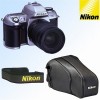Nikon F80QD User Manual - Page 16
Using Built-In Speedlight
 |
UPC - 718122227020
View all Nikon F80QD manuals
Add to My Manuals
Save this manual to your list of manuals |
Page 16 highlights
BASIC OPERATION Using Built-In Speedlight 8 When the subject is dark or the shutter speed is slower than 1/60 sec., use the built-in Speedlight to avoid picture blur. Speedlight photography is also suitable for shooting backlit subjects. 8.1 Press the Speedlight lock-release button to release the Speedlight. The Speedlight starts charging automatically. Check points The built-in Speedlight offers an angle of coverage of 28mm lens with a guide number of 12 (ISO 100, m). Using a D- or G-type Nikkor lens enables use of 3D Multi-Sensor Balanced Fill-Flash. (For details, see page 78.) Be sure to remove (or store) the lens hood before flash shooting. Some lenses have limitations using the built-in Speedlight and may cause vignetting. (For details, see page 84.) 8.2 Confirm fi in viewfinder, then compose, focus and take the picture. • See page 80 if the flash sync mode is not set to the normal Front-Curtain Sync. • When the Speedlight is ready to fire, fi appears without blinking in the viewfinder (when the camera's meter is on). • To close the Speedlight, press gently until it clicks shut. (To conserve power, keep the Speedlight closed when it is not in use.) Suitable situations for use of Speedlight • Shutter speed is slower than 1/60 sec. • Subject is dark at night or indoors. • Subject is backlit or when more light is desired on the main subject, such as the subject's face. NOTE: Continuous use of built-in Speedlight After continuous use of the built-in Speedlight, it may stop firing to protect the firing tube. Wait for a while before using the Speedlight again. 30 • The shutter cannot be released unless fi appears without blinking in the viewfinder. • fi blinks in the viewfinder approx. 3 sec. after full flash output. If this happens, underexposure may have occurred. Check the flash shooting distance range (page 83) and shoot again. • Normal Front-Curtain Sync flash mode is introduced in this section. Flash with Red-Eye Reduction, which reduces the "red-eye" effect with a person or animal, and Slow Sync flash, which brings out the background details, are also available. For details, see page 80. • With dark subjects, the camera's AF-Assist Illuminator is automatically activated to guide autofocus. See page 43 for details. 3D Multi-Sensor Balanced Fill-Flash When a D- or G-type Nikkor lens is attached, it integrates Distance Information from the lens with other exposure control information, automatically compensating the flash output level so that flash output and ambient light are balanced (page 78). 31















